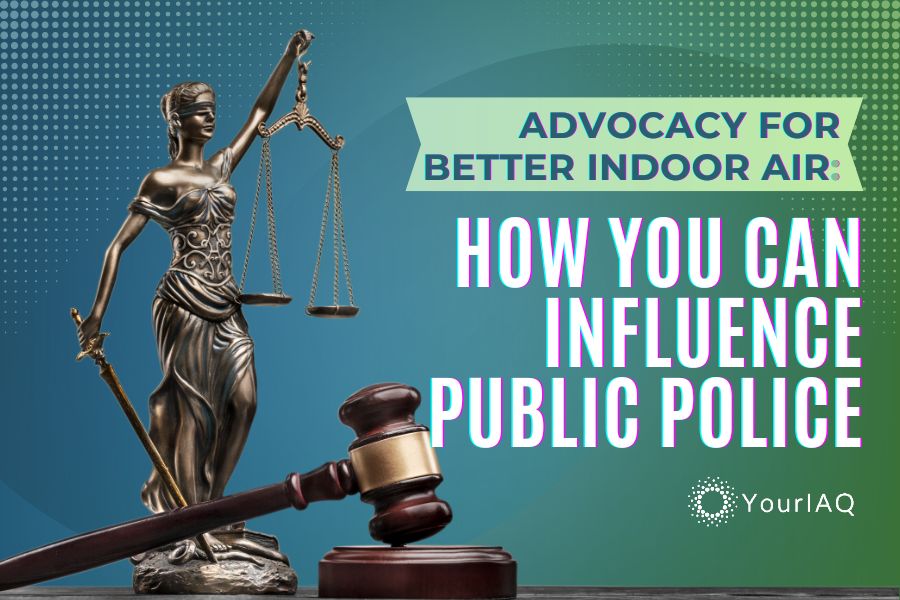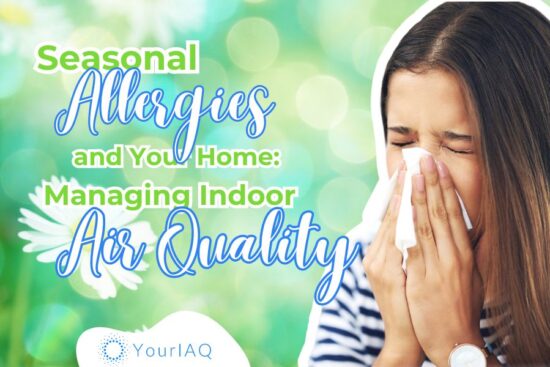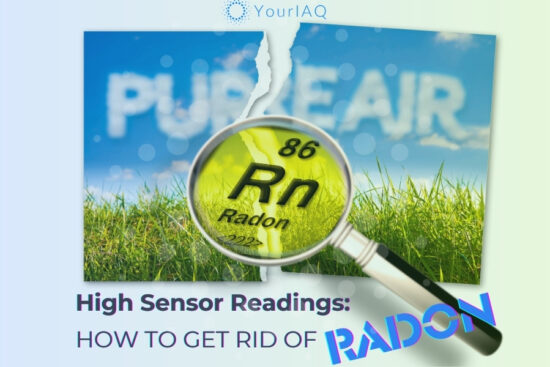
In today’s world, where we spend a significant portion of our time indoors, the quality of the air we breathe is more important than ever. We all deserve a genuine deep breath of clean, healthy air. But sadly, for many, the reality is filled with dust mites, mold, and chemicals – these silent saboteurs impact our health, well-being, and even our wallets.
But here’s the good news: you can be a champion for change!
Understanding indoor air pollution policies becomes crucial. Let’s dive into how you can play a pivotal role in advocating for better indoor air quality through public policy.
Why Advocate for Better Indoor Air?
The numbers paint a clear picture: poor indoor air quality contributes to a staggering $820 billion in healthcare costs annually, according to the Natural Resources Defense Council (NRDC).
The health effects of poor IAQ range from short-term irritations (eye and throat discomfort) to long-term health conditions such as respiratory diseases, heart disease, cancer, and even cognitive decline.
In fact, WHO reports that around 3.8 million premature deaths annually are attributed to indoor air pollution, highlighting the critical nature of this issue. But let’s not just throw around statistics.
Think about your own experience.
Do you ever feel sluggish after spending hours indoors? Does your child struggle with allergies? Do you or your elderly members get headaches more often when spending extended time indoors?
These everyday occurrences are not coincidental; they are direct reflections of the air quality in our living and working environments.
Indoor air pollution policies are thus crucial in setting standards and guidelines to manage and mitigate the presence of harmful pollutants in indoor environments. The development and enforcement of such robust policies are essential for ensuring that all indoor spaces—homes, schools, or workplaces—are safe and conducive to good health.
Wanna know how you can influence it? Continue reading.
Understanding the Policy Landscape
Existing Policies and Regulations
While we’re all familiar with National Ambient Air Quality Standards (NAAQS) protecting outdoor air, understanding the landscape of indoor air quality (IAQ) regulations can feel like navigating a maze. While the EPA sets these standards for outdoor air, there’s no comparable comprehensive framework for indoor spaces. This means we rely on a patchwork of regulations, often varying significantly from state to state and even city to city.
For example, some municipalities address building materials and ventilation codes, impacting IAQ to some degree. However, these regulations are inconsistent and leave many gaps unaddressed.
Similarly, the Consumer Product Safety Commission (CPSC) sets standards for specific products like formaldehyde emissions in wood panels. Yet, many everyday items that impact IAQ remain largely unregulated, with their potential health risks unassessed.
Initiatives like LEED certification promote sustainable building practices that often lead to improved IAQ. While such programs are valuable, their voluntary nature and potential affordability hurdles limit their widespread impact.
While policies are in place to improve indoor air quality (IAQ), there’s still a big gap when it comes to comprehensive and enforceable protections. Here’s why:
- Rules vary wildly: Different states and even cities have different rules, making it confusing and inconsistent. This patchwork approach leaves many people unprotected.
- Current rules can’t keep up: They often don’t cover all the places we spend time, like schools and workplaces, or the latest threats like microplastics.
- Science moves fast: What we know about IAQ and its health impacts keeps changing. Policies need to keep up with the latest findings.
- People need to know more: Even good policies won’t work if people don’t understand IAQ and their rights.
Read more: Exploring How Different Countries Approach Indoor Air Quality
Where Does Public Policy Come In?
Government regulations play a crucial role in setting standards for building materials, ventilation systems, and even everyday products that impact indoor air quality. The American Lung Association, a leading advocacy group, highlights how these regulations influence everything from building material emissions to the use of safer cleaning products.
By advocating for stricter regulations, we can create a safer environment for everyone. Think of it as building healthier homes, schools, and workplaces – brick by legislative brick.
Related reading: Indoor Air Quality Regulation: What Are the Standards?
So, How Can You Be an Advocate?
It’s easier than you think! Here are some action steps to get you started:
1. Get informed
Educate yourself on the current state of indoor air quality regulations and the health risks associated with poor air. Resources like the EPA’s website (https://www.epa.gov/indoor-air-quality-iaq) and the American Lung Association’s fact sheets (https://www.lung.org/clean-air/indoor-air) are a great starting point!
2. Engage with policymakers
Identify your local, state, and federal representatives who have jurisdiction over environmental and public health issues. Prepare a concise, evidence-based argument for why improving current legislation regarding indoor air pollution is critical. Schedule meetings, write letters, or make phone calls to share your concerns and suggestions with these officials.
If comfortable, share personal stories to emphasize the impact on your community.
3. Participate in Public Forums
Public forums, such as town hall meetings, regulatory hearings, and community events, offer opportunities to voice your concerns about IAQ. Attend these forums to ask questions, present data, and advocate for stronger indoor air pollution policies.
Public forums also provide a platform to engage with a broader audience, including other community members, activists, and media, amplifying the reach of your advocacy efforts.
4. Monitor and Respond to Policy Proposals
Stay informed about proposed changes to IAQ policies at the local, state, and federal levels. Government websites and environmental advocacy groups often provide updates on relevant legislation and regulatory actions.
When new policies are proposed, submit public comments expressing your support or concerns. Encourage others in your network to do the same to demonstrate widespread public interest in IAQ issues.
5. Join or form advocacy groups
As the saying goes, “There is strength in numbers.”
Connect with local advocacy groups or environmental organizations working on similar issues. These organizations often have established networks and resources that can amplify your efforts. If no such group exists in your area, consider forming one.
Together, your voices become a chorus that can’t be ignored. Check out the directory on the Environmental Working Group’s website (https://www.ewg.org/healthyhomeguide/) to find groups near you.
6. Support businesses that prioritize clean air
Look for companies committed to using sustainable materials and implementing healthy building practices. Your purchasing power has a voice!
To identify such companies, check out certifications like LEED by the U.S. Green Building Council (https://www.usgbc.org/) and WELL by the International WELL Building Institute (https://www.wellcertified.com/).
7. Raise awareness through Facebook, Twitter, and Instagram
Social media is a powerful tool for raising awareness and rallying support for policy changes. Create and share content that highlights the importance of IAQ, the risks associated with indoor air pollution, and the need for improved policies.
Use hashtags, tag policymakers & social media influencers, and encourage your network to share your posts to increase visibility. Social media campaigns are a great way to organize petitions, coordinate letter-writing campaigns, or announce public forums and advocacy events, as everyone prefers digital now.
Resources and Organizations for IAQ Policy Advocacy
Ready to take action? Awesome! You’re not alone in the fight for cleaner air indoors.
Here’s where you can find tons of resources and amazing organizations to help you make a difference:
Government Agencies:
- Environmental Protection Agency (EPA): The EPA provides extensive information on indoor air quality (IAQ) regulations, health risks, and resources for improving IAQ in homes, schools, and workplaces. (https://www.epa.gov/indoor-air-quality-iaq)
- Department of Housing and Urban Development (HUD): HUD offers resources and programs related to healthy homes and affordable housing, including IAQ concerns. (https://www.hud.gov/)
- Centers for Disease Control and Prevention (CDC): The CDC provides information on the health risks associated with poor IAQ, including asthma, allergies, and respiratory infections. (https://www.cdc.gov/air/trailerstudy/pdfs/femaindoorairqualityfactsheet.pdf)
- Consumer Product Safety Commission (CPSC): Issues regulations on safe consumer products and advocates for IAQ improvements in household goods. (https://www.cpsc.gov/)
- Occupational Safety and Health Administration (OSHA): Sets and enforces workplace safety standards, including regulations for IAQ in occupational settings. (https://www.osha.gov/)
- US Green Building Council (USGBC): Promotes sustainable building practices that significantly improve IAQ through their LEED certification program. (https://www.usgbc.org/)
Professional Associations:
- American Lung Association: A leading advocacy organization for clean air and healthy lungs, offering information and resources on IAQ policy and advocacy efforts. (https://www.lung.org/)
- American Public Health Association (APHA): A public health organization advocating for policies that promote healthy environments, including improved IAQ. (https://www.apha.org/)
- Building Owners and Managers Association (BOMA): A trade association representing commercial real estate owners and managers, with resources on sustainable building practices that can improve IAQ. (https://www.boma.org/)
- American Society of Heating, Refrigerating and Air-Conditioning Engineers (ASHRAE): Develops guidelines and standards for building systems that impact IAQ. (https://www.ashrae.org/)
- Healthy Schools Campaign: Advocating for healthy learning environments, including addressing IAQ concerns in schools. (https://www.healthyschoolscampaign.org/)
- Children’s Environmental Health Network (CEHN): Focuses on protecting children from environmental health hazards, including poor IAQ in homes and schools. (https://www.cehn.org/)
Non-Profit Organizations:
- Environmental Working Group (EWG): A non-profit organization providing research and advocacy on environmental health issues, including IAQ in homes and consumer products. (https://www.ewg.org/)
- National Healthy Homes Coalition: A coalition of organizations working to ensure healthy homes for all, including advocacy for improved IAQ policies. (https://www.healthyhomescoalition.org/)
- Alliance for Healthy Interiors: A non-profit organization working to create healthier indoor environments through education, advocacy, and research. (https://practicegreenhealth.org/topics/safer-chemicals/healthy-interiors)
- National Center for Healthy Housing (NCHH): Provides education and resources for healthy homes, including information on IAQ hazards and solutions. (https://www.nchh.org/)
- Greenpeace: Engages in advocacy around various environmental issues, including advocating for stricter regulations on building materials and products that impact IAQ. (https://www.greenpeace.org/international/)
- National Institute of Environmental Health Sciences (NIEHS): Conducts research on environmental health impacts, including the effects of poor IAQ on human health. (https://www.niehs.nih.gov/)
Community Platforms:
- CitizenLab: A platform connecting citizens with local government and advocacy groups, allowing you to find and engage with IAQ-related initiatives in your community. (https://www.citizenlab.co/)
- Nextdoor: A social networking platform for neighborhoods, where you can connect with neighbors, share concerns, and potentially organize around local IAQ issues. (https://nextdoor.com/)
- Change.org: A platform for starting and joining online petitions advocating for various causes, including IAQ policy changes. (https://www.change.org/)
- Local environmental groups: Many regions have active environmental groups working on various issues, including IAQ advocacy. Search online or contact local environmental organizations for relevant groups near you.
- Public comment platforms: Government agencies often provide platforms for public comment on proposed regulations, including those related to IAQ. (https://www.regulations.gov/)
- Environmental news and advocacy websites: Stay informed about current IAQ-related issues and advocacy efforts through platforms like EcoWatch, Climate Nexus, and Inside Climate News.
Your Actions Shape Healthier Indoor Air
Indoor air pollution, often lurking in our own homes, can steal our health, burden our wallets, and dim our quality of life. The statistics are sobering, but the good news is we hold the power to change it.
By understanding the gaps in indoor air quality policies, by raising our voices with policymakers and in public forums, and by leveraging the power of social media, we can push for stronger regulations.
This isn’t just about fighting a global health issue; it’s about impacting lives today and building a stronger foundation for a healthier tomorrow.
Take the steps outlined in this guide, share your voice, and become an advocate.
Indoor Air Pollution Policies FAQs
Is poor indoor air quality really a problem?
Yes, absolutely. The EPA estimates that indoor air can be two to five times more polluted than outdoor air, and the CDC links it to various health problems.
What are some common indoor air pollutants?
Dust mites, mold, volatile organic compounds (VOCs) from cleaning products and building materials, radon gas, and secondhand smoke are some of the most common culprits.
What can I do to improve the air quality in my home?
Increase ventilation, use air purifiers, regularly clean and maintain heating and cooling systems, reduce humidity levels, and avoid using harsh chemicals.
How can technology improve IAQ?
Technology like air purifiers and advanced HVAC systems can significantly reduce indoor pollutants, especially when supported by effective policies.
How can I stay informed about advocacy efforts?
Follow reliable organizations like the EPA, the American Lung Association, and local environmental groups on social media or subscribe to their newsletters.
How much time does it take to get involved in advocacy?
Even small actions like sending an email or contacting your elected official can make a difference. You can choose the level of involvement that fits your time and interests.
Are there financial incentives for using eco-friendly building materials or installing air purifiers?
Some government programs and local initiatives offer tax credits or rebates for sustainable choices that improve indoor air quality. It’s worth researching options in your area.
I rent my home. Can I still advocate for better air quality?
While you may not have direct control over building modifications, you can discuss concerns with your landlord and explore options like portable air purifiers or improved ventilation strategies.







